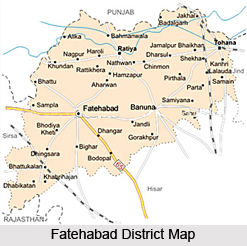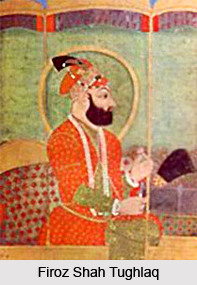 Fatehabad District is one of the 21 administrative districts of Haryana and Fatehabad town is the district headquarters. Fatehabad District is surrounded by Punjab in the north, by Hisar District in the south, by Jind District in the east and by Rajasthan and Sirsa District in the west. Total geographical area of the district is 2520 sq kms which is around 5.4 percent of the total area of the state.
Fatehabad District is one of the 21 administrative districts of Haryana and Fatehabad town is the district headquarters. Fatehabad District is surrounded by Punjab in the north, by Hisar District in the south, by Jind District in the east and by Rajasthan and Sirsa District in the west. Total geographical area of the district is 2520 sq kms which is around 5.4 percent of the total area of the state.
History of Fatehabad District
Fatehabad District derives its name from its headquarters town Fatehabad. The town was founded by Firoz Shah Tughlaq in the 14th century. He named it after his son Fateh Khan, as Fatehabad. Fatehabad District was carved out of Hisar district on 15th of July, 1997.
Geography of Fatehabad District
Fatehabad District mainly comprises alluvial plains of Indo-Gangetic basin. There is no perennial river flowing through the district only a seasonal river that is Ghaggar River is flowing through Ratia and Jakhal. Bhakra and Western Yamuna are two main canals which irrigate most part of the district.
 The climate of Fatehabad District is of tropical type with intensively hot summer and cool winter, with a temperature of 47 degree Celsius in June and 2 degree Celsius in December and January. The average rainfall of the district is 400 mm.
The climate of Fatehabad District is of tropical type with intensively hot summer and cool winter, with a temperature of 47 degree Celsius in June and 2 degree Celsius in December and January. The average rainfall of the district is 400 mm.
Administration of Fatehabad District
Fatehabad District has three sub-divisions namely Fatehabad, Tohana and Ratia. Further, administration of Fatehabad District has six development blocks - Fatehabad, Tohana, Ratia, Bhattu, Bhuna and Jakhal. There are 243 habited villages in the district. Tehsil Tohana and Bhattu Block of Fatehabad district is well connected by broad gauge railway line with Punjab, Delhi and district Sirsa. Road transport in Fatehabad District is well developed. National Highway No.10 connects Fatehabad with Delhi and Punjab.
Demography of Fatehabad District
Total population of Fatehabad District as per 2001 Census is 806158, of which male population is 427536 and female population is 379622. Further, according to Census 2001, total literacy rate of the district is 58.17 percent. Urban literacy rate is 76.15 percent and rural literacy rate is 56.75 percent.
Fatehabad District is well equipped with agriculture marketing facilities. Further, there are three historical monuments known as `Shershah Ka Kila`, `Idgah` and Ashoka `Satambh`. There are about 38 big industries in the district.



















